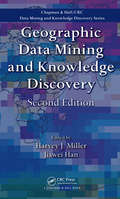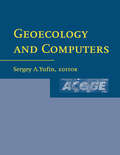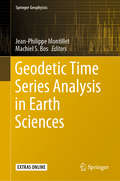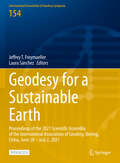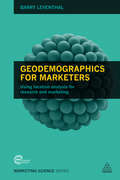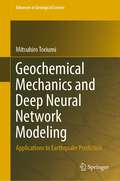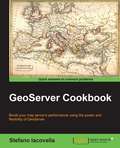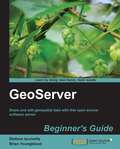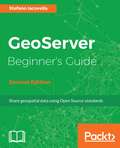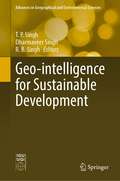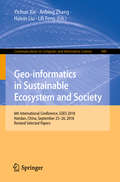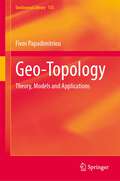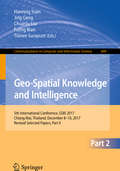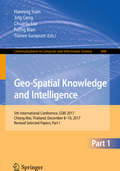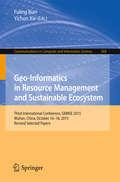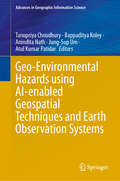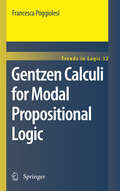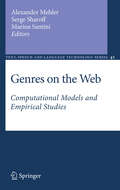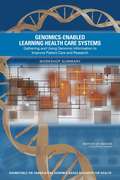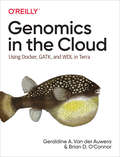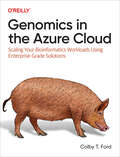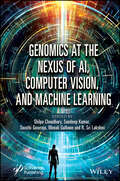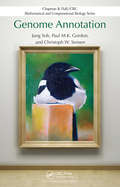- Table View
- List View
Geographic Data Mining and Knowledge Discovery (Chapman & Hall/CRC Data Mining and Knowledge Discovery Series)
by Jiawei Han Harvey J. MillerThe Definitive Volume on Cutting-Edge Exploratory Analysis of Massive Spatial and Spatiotemporal DatabasesSince the publication of the first edition of Geographic Data Mining and Knowledge Discovery, new techniques for geographic data warehousing (GDW), spatial data mining, and geovisualization (GVis) have been developed. In addition, there has bee
Geoecology and Computers
by Sergey A. YufinThis volume presents technical papers devoted to development and practical use of computer methods in geotechnical and geoenviromental engineering. It covers issues on space use and construction, soil and rock mechanics, and mining applications amongst other topics.
Geodetic Time Series Analysis in Earth Sciences (Springer Geophysics)
by Jean-Philippe Montillet Machiel S. BosThis book provides an essential appraisal of the recent advances in technologies, mathematical models and computational software used by those working with geodetic data. It explains the latest methods in processing and analyzing geodetic time series data from various space missions (i.e. GNSS, GRACE) and other technologies (i.e. tide gauges), using the most recent mathematical models. The book provides practical examples of how to apply these models to estimate seal level rise as well as rapid and evolving land motion changes due to gravity (ice sheet loss) and earthquakes respectively. It also provides a necessary overview of geodetic software and where to obtain them.
Geodesy for a Sustainable Earth: Proceedings of the 2021 Scientific Assembly of the International Association of Geodesy, Beijing, China, June 28 – July 2, 2021 (International Association of Geodesy Symposia #154)
by Jeffrey T. Freymueller Laura SánchezThis open access volume contains selected papers of the 2021 Scientific Assembly of the International Association of Geodesy – IAG2021. The Assembly was hosted by the Chinese Society for Geodesy, Photogrammetry and Cartography (CSGPC) in Beijing, China from June 28 to July 2, 2021. It was a hybrid conference with in-person and online attendants. In total, the Assembly was attended by 146 in-person participants and 1,123 online participants. The theme of the Assembly was Geodesy for a Sustainable Earth. 613 contributions (255 oral presentations and 358 poster presentations) covered all topics of the broad spectrum considered by the IAG: geodetic reference frames, Earth gravity field modelling, Earth rotation and geodynamics, positioning and applications, the Global Geodetic Observing System (GGOS), geodesy for climate research, marine geodesy, and novel sensors and quantum technology for geodesy. All published papers were peer-reviewed, and we warmly recognize the contributions and support of the Associate Editors and Reviewers.
Geodemographics for Marketers
by Barry LeventhalGeodemographics, the process of analyzing survey data to profile economic and demographic characteristics of populations, is a successful data-driven analysis tool for marketers. Geodemographic classifications are widely embedded in customer databases and market research datasets. Written by a leading UK authority on geodemographics, Geodemographics for Marketers provides marketers with the know-how to leverage it as an effective research tool to identify location-based segments for highly targeted marketing. International in scope and impartial in its approach, this book demonstrates how to implement geodemographics techniques for practical application in retail, financial services and telecommunications as well as the public sector. Geodemographics for Marketers includes numerous case studies, from the automotive, retail and telecommunications sectors to the public sector, that illustrate core concepts and how they can be applied to gain positive results. The book also incorporates the newly introduced generation of classifications, as well as a discussion of the key decisions of the proposed 2021 census.
Geochemical Mechanics and Deep Neural Network Modeling: Applications to Earthquake Prediction (Advances in Geological Science)
by Mitsuhiro ToriumiThe recent understandings about global earth mechanics are widely based on huge amounts of monitoring data accumulated using global networks of precise seismic stations, satellite monitoring of gravity, very large baseline interferometry, and the Global Positioning System. New discoveries in materials sciences of rocks and minerals and of rock deformation with fluid water in the earth also provide essential information. This book presents recent work on natural geometry, spatial and temporal distribution patterns of various cracks sealed by minerals, and time scales of their crack sealing in the plate boundary. Furthermore, the book includes a challenging investigation of stochastic earthquake prediction testing by means of the updated deep machine learning of a convolutional neural network with multi-labeling of large earthquakes and of the generative autoencoder modeling of global correlated seismicity. Their manifestation in this book contributes to the development of human society resilient from natural hazards. Presented here are (1) mechanics of natural crack sealing and fluid flow in the plate boundary regions, (2) large-scale permeable convection of the plate boundary, (3) the rapid process of massive extrusion of plate boundary rocks, (4) synchronous satellite gravity and global correlated seismicity, (5) Gaussian network dynamics of global correlated seismicity, and (6) prediction testing of plate boundary earthquakes by machine learning and generative autoencoders.
GeoServer Cookbook
by Stefano IacovellaThis book is ideal for GIS experts, developers, and system administrators who have had a first glance at GeoServer and who are eager to explore all its features in order to configure professional map servers. Basic knowledge of GIS and GeoServer is required.
GeoServer Beginner’s Guide
by Brian Youngblood Stefano IacovellaStep-by-step instructions are included and the needs of a beginner are totally satisfied by the book. The book consists of plenty of examples with accompanying screenshots and code for an easy learning curve. You are a web developer with knowledge of server side scripting, and have experience with installing applications on the server. You have a desire to want more than Google maps, by offering dynamically built maps on your site with your latest geospatial data stored in MySQL, PostGIS, MsSQL or Oracle. If this is the case, this book is meant for you.
GeoServer Beginner's Guide - Second Edition
by Stefano IacovellaThis step-by-step guide will teach you how to use GeoServer to build custom and interactive maps using your data. About This Book • Exploit the power of GeoServer to provide agile, flexible, and low -cost community projects • Share real-time maps quickly • Boost your map server's performance using the power and flexibility of GeoServer Who This Book Is For If you are a web developer with knowledge of server side scripting, have experience in installing applications on the server, and want to go beyond Google Maps by offering dynamically built maps on your site with your latest geospatial data stored in MySQL, PostGIS, MySQL, or Oracle, this is the book for you. What You Will Learn • Install GeoServer quickly • Access dynamic real-time geospatial data that you can easily integrate into your own web-based application • Create custom styles for lines, points, and polygons for great-looking maps • Command GeoServer remotely using REST • Tune your GeoServer instance for performance • Move GeoServer into production • Learn advanced topics to extend GeoServer's capabilities In Detail GeoServer is an opensource server written in Java that allows users to share, process, and edit geospatial data. This book will guide you through the new features and improvements of GeoServer and will help you get started with it. GeoServer Beginner's Guide gives you the impetus to build custom maps using your data without the need for costly commercial software licenses and restrictions. Even if you do not have prior GIS knowledge, you will be able to make interactive maps after reading this book. You will install GeoServer, access your data from a database, and apply style points, lines, polygons, and labels to impress site visitors with real-time maps. Then you follow a step-by-step guide that installs GeoServer in minutes. You will explore the web-based administrative interface to connect to backend data stores such as PostGIS, and Oracle. Going ahead, you can display your data on web-based interactive maps, use style lines, points, polygons, and embed images to visualize this data for your web visitors. You will walk away from this book with a working application ready for production. After reading GeoServer Beginner's Guide, you will be able to build beautiful custom maps on your website using your geospatial data. Style and approach Step-by-step instructions are included and the needs of a beginner are totally satisfied by the book. The book consists of plenty of examples with accompanying screenshots and code for an easy learning curve.
Geo-intelligence for Sustainable Development (Advances in Geographical and Environmental Sciences)
by R. B. Singh T. P. Singh Dharmaveer SinghGlobally, concerns for the environment and human well-being have increased as results of threats imposed by climate change and disasters, environmental degradation, pollution of natural resources, water scarcity and proliferation of slums. Finding appropriate solutions to these threats and challenges is not simple, as these are generally complex and require state-of-the-art technology to collect, measure, handle and analyse large volumes of varying data sets. However, the recent advances in sensor technology, coupled with the rapid development of computational power, have greatly enhanced our abilities to capture, store and analyse the surrounding physical environment. This book explores diverse dimensions of geo-intelligence (GI) technology in developing a computing framework for location-based, data-integrating earth observation and predictive modelling to address these issues at all levels and scales. The book provides insight into the applications of GI technology in several fields of spatial and social sciences and attempts to bridge the gap between them.
Geo-informatics in Sustainable Ecosystem and Society: 6th International Conference, GSES 2018, Handan, China, September 25–26, 2018, Revised Selected Papers (Communications in Computer and Information Science #980)
by Yichun Xie Anbing Zhang Haixin Liu Lili FengThis book constitutes the refereed proceedings of the 6th International Conference on Geo-informatics in Sustainable Ecosystem and Society, GSES 2018, held in Handan, China, in September 2018. The 46 papers presented in this volume were carefully reviewed and selected from 153 submissions and focus on spatial data acquisition, processing and management, modeling and analysis, and recent applications in the context of building healthier ecology and resource management using advanced remote sensing technology and spatial data modeling and analysis.
Geo-Topology: Theory, Models and Applications (GeoJournal Library #133)
by Fivos PapadimitrouGeo-Topology is an exploration of the depth and breadth of the relationships between Geography and Topology, with applications ranging from Landscape Geography to Social Geography and from Spatial Analysis to Geospatial Technologies. It shows how topics of geographical research (landscapes, borders, spatial social relationships etc) can be examined by using mathematical concepts and methods of Topology, exposing the realm of geo-topological modelling and visualization through Point-Set Topology, Knot Theory, Reeb graphs, Topological Surfaces (i.e. Möbius bands and Klein bottles), Differential Topology, Network Analysis, Combinatorial Topology, Braid Theory and Ultrametric Topology. Besides geographers, this book is a trove of new ideas for landscape ecologists, mathematicians, data scientists, sociologists, psychologists, anthropologists and educators. Geo-Topology is a systematic introduction to topological thinking in Geography, also by highlighting the significance of Topology for Geographical Education, as well as for the Philosophy and Epistemology of Geography.
Geo-Spatial Knowledge and Intelligence: 5th International Conference, GSKI 2017, Chiang Mai, Thailand, December 8-10, 2017, Revised Selected Papers, Part II (Communications in Computer and Information Science #849)
by Fuling Bian Hanning Yuan Jing Geng Chuanlu Liu Tisinee SurapuntThis two-volume set (CCIS 848 and CCIS 849) constitutes the thoroughly refereed proceedings of the 5th International Conference Geo-Spatial Knowledge and Intelligence, GSKI 2017, held in Chiang Mai, Thailand, in December 2018.The 142 full papers presented were carefully reviewed and selected from 579 submissions. They are organized in topical sections on smart city in resource management and sustainable ecosystem; spatial data acquisition through RS and GIS in resource management and sustainable ecosystem; ecological and environmental data processing and management; advanced geospatial model and analysis for understanding ecological and environmental process; applications of geo-informatics in resource management and sustainable ecosystem.
Geo-Spatial Knowledge and Intelligence: 5th International Conference, GSKI 2017, Chiang Mai, Thailand, December 8-10, 2017, Revised Selected Papers, Part I (Communications in Computer and Information Science #848)
by Fuling Bian Hanning Yuan Jing Geng Chuanlu Liu Tisinee SurapuntThis two-volume set (CCIS 848 and CCIS 849) constitutes the thoroughly refereed proceedings of the 5th International Conference Geo-Spatial Knowledge and Intelligence, GSKI 2017, held in Chiang Mai, Thailand, in December 2018.The 142 full papers presented were carefully reviewed and selected from 579 submissions. They are organized in topical sections on smart city in resource management and sustainable ecosystem; spatial data acquisition through RS and GIS in resource management and sustainable ecosystem; ecological and environmental data processing and management; advanced geospatial model and analysis for understanding ecological and environmental process; applications of geo-informatics in resource management and sustainable ecosystem.
Geo-Informatics in Resource Management and Sustainable Ecosystem: Third International Conference, GRMSE 2015, Wuhan, China, October 16-18, 2015, Revised Selected Papers (Communications in Computer and Information Science #569)
by Fuling Bian Yichun XieThis volume constitutes the refereed proceedings of the Third International Conference on Geo-Informatics in Resource Management and Sustainable Ecosystem, GRMSE 2015, held in Wuhan, China, in October 2015.The 101 papers presented were carefully reviewed and selected from 321 submissions. The papers are divided into topical sections on Smart City in Resource Management and Sustainable Ecosystem; Spatial Data Acquisition Through RS and GIS in Resource Management and Sustainable Ecosystem; Ecological and Environmental Data Processing and Management; Advanced Geospatial Model and Analysis for Understanding Ecological and Environmental Process; Applications of Geo-Informatics in Resource Management and Sustainable Ecosystem.
Geo-Environmental Hazards using AI-enabled Geospatial Techniques and Earth Observation Systems (Advances in Geographic Information Science)
by Jung-Sup Um Tanupriya Choudhury Bappaditya Koley Anindita Nath Atul Kumar PatidarThis edited collection provides a comprehensive exploration of cutting-edge ideas, approaches, simulations, evaluations of risk, and systems that enhance the practicality of current geospatial technologies for reducing hazard risks. The various sections within this book delve into subjects such as the foundational principles of Earth Observation Systems (EOS) and geospatial methodologies. Additionally, the text serves as an advisory resource on the collaborative use of satellite-derived data and artificial intelligence to track and alleviate geo-environmental threats. The volume imparts extensive understanding regarding geo-environmental dangers and their analysis via EOS along with geospatial strategies. It encompasses key hazard-related themes including coastal degradation, predisposition to landslides, mapping vegetation coverages, tropical storm patterns, soil depletion due to erosion processes, vulnerability to rapid or extended flooding events, variations in oceansurface temperatures alongside chlorophyll-a levels; it also addresses assessments related to groundwater reserves and quality measures as well as sustainable management practices for watersheds that support community livelihoods—all through leveraging AI-integrated geospatial tools in conjunction with earth observation technologies. Furthermore, this work engages in discourse about systems designed for mitigating these ecological challenges sustainably. Scholars engaged in research activities; educational professionals; those involved in landscape design; engineers working at ground level; individuals responsible for policy-making—all who are concerned with geo-environmental hazards or associated domains—will find valuable insights within these pages.
Gentzen Calculi for Modal Propositional Logic
by Francesca PoggiolesiThe book is about Gentzen calculi for (the main systems of) modal logic. It is divided into three parts. In the first part we introduce and discuss the main philosophical ideas related to proof theory, and we try to identify criteria for distinguishing good sequent calculi. In the second part we present the several attempts made from the 50's until today to provide modal logic with Gentzen calculi. In the third and and final part we analyse new calculi for modal logics, called tree-hypersequent calculi, which were recently introduced by the author. We show in a precise and clear way the main results that can be proved with and about them.
Genres on the Web
by Alexander Mehler Serge Sharoff Marina SantiniThe volume "Genres on the Web" has been designed for a wide audience, from the expert to the novice. It is a required book for scholars, researchers and students who want to become acquainted with the latest theoretical, empirical and computational advances in the expanding field of web genre research. The study of web genre is an overarching and interdisciplinary novel area of research that spans from corpus linguistics, computational linguistics, NLP, and text-technology, to web mining, webometrics, social network analysis and information studies. This book gives readers a thorough grounding in the latest research on web genres and emerging document types. The book covers a wide range of web-genre focused subjects, such as: * The identification of the sources of web genres * Automatic web genre identification * The presentation of structure-oriented models * Empirical case studies One of the driving forces behind genre research is the idea of a genre-sensitive information system, which incorporates genre cues complementing the current keyword-based search and retrieval applications.
Genomics-Enabled Learning Health Care Systems: Workshop Summary
by Sarah H. BeachyThe inclusion of genomic data in a knowledge-generating health care system infrastructure is one promising way to harness the full potential of that information to provide better patient care. In such a system, clinical practice and research influence each other with the goal of improving the efficiency and effectiveness of disease prevention, diagnosis, and treatment. To examine pragmatic approaches to incorporating genomics in learning health care systems, the Institute of Medicine Roundtable on Translating Genomic-Based Research for Health hosted a workshop which convened a variety of stakeholder groups, including commercial developers, health information technology professionals, clinical providers, academic researchers, patient groups, and government and health system representatives, to present their perspectives and participate in discussions on maximizing the value that can be obtained from genomic information. The workshop examined how a variety of systems are capturing and making use of genomic data to generate knowledge for advancing health care in the 21st century. It also sought to evaluate the challenges, opportunities, and best practices for capturing or using genomic information in knowledge-generating health care systems. "Genomics-Enabled Learning Health Care Systems" summarizes the presentations and discussion of the workshop.
Genomics-Enabled Learning Health Care Systems: Workshop Summary
by Sarah H. BeachyThe inclusion of genomic data in a knowledge-generating health care system infrastructure is one promising way to harness the full potential of that information to provide better patient care. In such a system, clinical practice and research influence each other with the goal of improving the efficiency and effectiveness of disease prevention, diagnosis, and treatment. To examine pragmatic approaches to incorporating genomics in learning health care systems, the Institute of Medicine Roundtable on Translating Genomic-Based Research for Health hosted a workshop which convened a variety of stakeholder groups, including commercial developers, health information technology professionals, clinical providers, academic researchers, patient groups, and government and health system representatives, to present their perspectives and participate in discussions on maximizing the value that can be obtained from genomic information. The workshop examined how a variety of systems are capturing and making use of genomic data to generate knowledge for advancing health care in the 21st century. It also sought to evaluate the challenges, opportunities, and best practices for capturing or using genomic information in knowledge-generating health care systems. Genomics-Enabled Learning Health Care Systems summarizes the presentations and discussion of the workshop.
Genomics in the Cloud: Using Docker, GATK, and WDL in Terra
by Geraldine A. Van der Auwera Brian D. O'ConnorData in the genomics field is booming. In just a few years, organizations such as the National Institutes of Health (NIH) will host 50+ petabytesâ??or over 50 million gigabytesâ??of genomic data, and theyâ??re turning to cloud infrastructure to make that data available to the research community. How do you adapt analysis tools and protocols to access and analyze that volume of data in the cloud?With this practical book, researchers will learn how to work with genomics algorithms using open source tools including the Genome Analysis Toolkit (GATK), Docker, WDL, and Terra. Geraldine Van der Auwera, longtime custodian of the GATK user community, and Brian Oâ??Connor of the UC Santa Cruz Genomics Institute, guide you through the process. Youâ??ll learn by working with real data and genomics algorithms from the field.This book covers:Essential genomics and computing technology backgroundBasic cloud computing operationsGetting started with GATK, plus three major GATK Best Practices pipelinesAutomating analysis with scripted workflows using WDL and CromwellScaling up workflow execution in the cloud, including parallelization and cost optimizationInteractive analysis in the cloud using Jupyter notebooksSecure collaboration and computational reproducibility using Terra
Genomics in the Azure Cloud: Scaling Your Bioinformatics Workloads Using Enterprise-Grade Solutions
by Colby T. FordThis practical guide bridges the gap between general cloud computing architecture in Microsoft Azure and scientific computing for bioinformatics and genomics. You'll get a solid understanding of the architecture patterns and services that are offered in Azure and how they might be used in your bioinformatics practice. You'll get code examples that you can reuse for your specific needs. And you'll get plenty of concrete examples to illustrate how a given service is used in a bioinformatics context.You'll also get valuable advice on how to:Use enterprise platform services to easily scale your bioinformatics workloadsOrganize, query, and analyze genomic data at scaleBuild a genomics data lake and accompanying data warehouseUse Azure Machine Learning to scale your model training, track model performance, and deploy winning modelsOrchestrate and automate processing pipelines using Azure Data Factory and DatabricksCloudify your organization's existing bioinformatics pipelines by moving your workflows to Azure high-performance compute servicesAnd more
Genomics at the Nexus of AI, Computer Vision, and Machine Learning
by Sandeep Kumar Shilpa Choudhary Swathi Gowroju R. Sri Lakshmi Monali GulhaneThe book provides a comprehensive understanding of cutting-edge research and applications at the intersection of genomics and advanced AI techniques and serves as an essential resource for researchers, bioinformaticians, and practitioners looking to leverage genomics data for AI-driven insights and innovations. The book encompasses a wide range of topics, starting with an introduction to genomics data and its unique characteristics. Each chapter unfolds a unique facet, delving into the collaborative potential and challenges that arise from advanced technologies. It explores image analysis techniques specifically tailored for genomic data. It also delves into deep learning showcasing the power of convolutional neural networks (CNN) and recurrent neural networks (RNN) in genomic image analysis and sequence analysis. Readers will gain practical knowledge on how to apply deep learning techniques to unlock patterns and relationships in genomics data. Transfer learning, a popular technique in AI, is explored in the context of genomics, demonstrating how knowledge from pre-trained models can be effectively transferred to genomic datasets, leading to improved performance and efficiency. Also covered is the domain adaptation techniques specifically tailored for genomics data. The book explores how genomics principles can inspire the design of AI algorithms, including genetic algorithms, evolutionary computing, and genetic programming. Additional chapters delve into the interpretation of genomic data using AI and ML models, including techniques for feature importance and visualization, as well as explainable AI methods that aid in understanding the inner workings of the models. The applications of genomics in AI span various domains, and the book explores AI-driven drug discovery and personalized medicine, genomic data analysis for disease diagnosis and prognosis, and the advancement of AI-enabled genomic research. Lastly, the book addresses the ethical considerations in integrating genomics with AI, computer vision, and machine learning. Audience The book will appeal to biomedical and computer/data scientists and researchers working in genomics and bioinformatics seeking to leverage AI, computer vision, and machine learning for enhanced analysis and discovery; healthcare professionals advancing personalized medicine and patient care; industry leaders and decision-makers in biotechnology, pharmaceuticals, and healthcare industries seeking strategic insights into the integration of genomics and advanced technologies.
Genomics and Bioinformatics
by Tore SamuelssonWith the arrival of genomics and genome sequencing projects, biology has been transformed into an incredibly data-rich science. The vast amount of information generated has made computational analysis critical and has increased demand for skilled bioinformaticians. Designed for biologists without previous programming experience, this textbook provides a hands-on introduction to Unix, Perl and other tools used in sequence bioinformatics. Relevant biological topics are used throughout the book and are combined with practical bioinformatics examples, leading students through the process from biological problem to computational solution. All of the Perl scripts, sequence and database files used in the book are available for download at the accompanying website, allowing the reader to easily follow each example using their own computer. Programming examples are kept at an introductory level, avoiding complex mathematics that students often find daunting. The book demonstrates that even simple programs can provide powerful solutions to many complex bioinformatics problems.
Genome Annotation (Chapman & Hall/CRC Computational Biology Series #46)
by Christoph W. Sensen Jung Soh Paul M.K. GordonThe success of individualized medicine, advanced crops, and new and sustainable energy sources requires thoroughly annotated genomic information and the integration of this information into a coherent model. A thorough overview of this field, Genome Annotation explores automated genome analysis and annotation from its origins to the challenges of next-generation sequencing data analysis.The book initially takes you through the last 16 years since the sequencing of the first complete microbial genome. It explains how current analysis strategies were developed, including sequencing strategies, statistical models, and early annotation systems. The authors then present visualization techniques for displaying integrated results as well as state-of-the-art annotation tools, including MAGPIE, Ensembl, Bluejay, and Galaxy. They also discuss the pipelines for the analysis and annotation of complex, next-generation DNA sequencing data. Each chapter includes references and pointers to relevant tools. As very few existing genome annotation pipelines are capable of dealing with the staggering amount of DNA sequence information, new strategies must be developed to accommodate the needs of today’s genome researchers. Covering this topic in detail, Genome Annotation provides you with the foundation and tools to tackle this challenging and evolving area. Suitable for both students new to the field and professionals who deal with genomic information in their work, the book offers two genome annotation systems on an accompanying downloadable resources.
